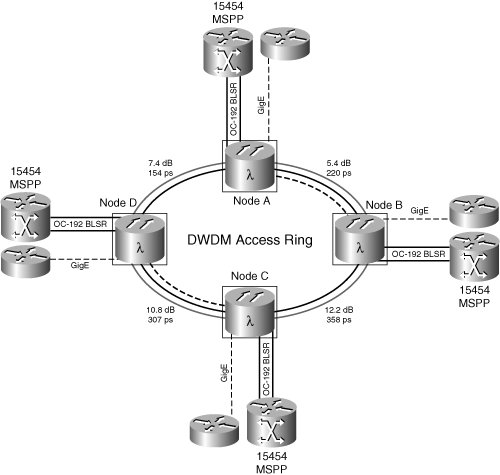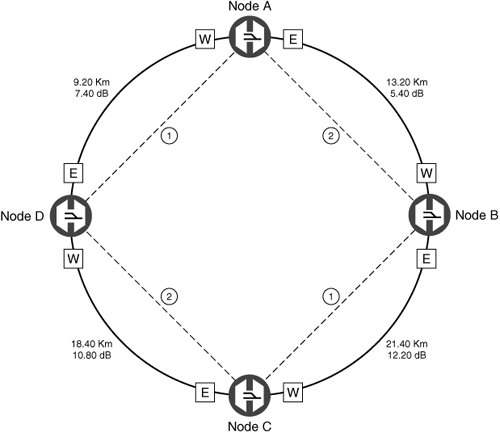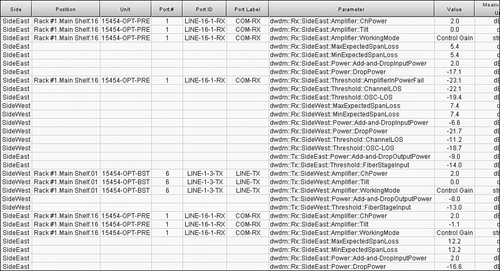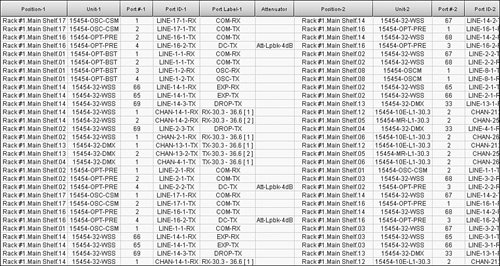ONS 15454 MSTP MetroPlanner Design Tool
| MetroPlanner is a Java-based design tool for the ONS 15454 MSTP system. It provides the DWDM designer with a computer-generated, visual DWDM design that can be used to verify DWDM spans, plan future DWDM system upgrades, and model various ONS 15454 MSTP topologies. The MetroPlanner system design rules thoroughly examine the planned DWDM topology design, from the basics of attenuation, chromatic dispersion, and OSNR, to other considerations, such as channel cross-talk, amplifier gain tilt, and so on. These rules are factored into the overall design layout. MetroPlanner offers the DWDM designer the following advantages:
To better understand the advantages of using MetroPlanner for ONS 15454 MSTP designs, consider an ONS 15454 MSTP ROADM ring-based DWDM design, in comparison to the simple linear example in the previous section. Figure 10-4 illustrates the DWDM ring design layout. Notice that the design requires a mixture of DWDM wavelength channel bit rates, in that GigE and Synchronous Optical Network (SONET) OC-192 wavelengths are required. Table 10-7 lists the transponder/muxponder requirements and associated channel plan.
Figure 10-4. ONS 15454 MSTP ROADM Ring Network Design Example Although only two wavelength channels will be in use, the ROADM configuration allows up to 32 channels at any node to be added or dropped; therefore, the optical design constraints for a full 32-channel system are taken into account. For this reason, the ROADM system need be designed only once, while channel capacity can be added, changed, or rearranged, as necessary. Simple/FlexibleThe MetroPlanner design tool enables the user to input DWDM topologies in one of two ways:
Regardless of which topology-input methodology is chosen, the ONS 15454 MSTP DWDM designer can input the node, fiber, and channel requirements for both simple and complex topologies in a matter of minutes. After the topology information has been input, the user has the full flexibility to insert fiber spans between nodes; modify fiber parameters such as distance, fiber type, chromatic dispersion values, and the like; modify node types (for example, ROADM, fixed-channel, pass-through, and so on); and change present and future DWDM channel requirements between nodes. Where uncertainty exists in network topology requirements, such as the type of node to be deployed at a location, the user can allow MetroPlanner to choose the nodes type(s) based upon the design input. Figure 10-5 shows the MetroPlanner design screen summary for the ROADM ring example. Figure 10-5. MetroPlanner ROADM Ring Design Input Screen Comprehensive AnalysisFor the simple linear example, you examined the DWDM topology by computing accumulated fiber attenuation, chromatic dispersion, and OSNR. These computations will suffice for most designs, but by no means should they be considered an exhaustive analysis of DWDM transmissions. By using the MetroPlanner design tool, the user is ensured of a more complete and comprehensive design analysis that includes such factors as optimized variable optical attenuator (VOA) settings, start-of-life (SOL) and end-of-life (EOL) transmission characteristics, and calculation of DCU placement and recommended DCU type/value. In addition, if the desired node/amplifier spacing impairs overall DWDM signal transmissions, the MetroPlanner design tool generates warnings to the user and then suggests alternative methods for design using port attenuation, amplifier placing/spacing, node type/placement, and so on. Figure 10-6 shows a partial example of the MetroPlanner span design analysis for the ROADM ring example. Figure 10-6. MetroPlanner ROADM Ring Design Analysis Sample Screen Installation/Turn-Up AssistanceTo further assist in the planning and implementation of ONS 15454 MSTP networks, the MetroPlanner tool provides equipment site layouts and network material requirements as output reports. By using the MetroPlanner point-and-click navigational screens, you can view a detailed list of equipment required at each site, with an included visual diagram of the equipment layout. These screens work as visual confirmation for the planned network, or can create an equipment work order to purchase the required network element parts. In addition to the site and network material lists, the MetroPlanner tool provides detailed channel power analysis to facilitate the initial setting of amplifier and VOA thresholds. This information can be exported to a file and uploaded to the individual ONS 15454 MSTP node for expedited site turn-up. After the initial settings have been uploaded for each node, the automatic power-monitoring capability of the ONS 15454 MSTP system takes control for future DWDM wavelength channel add/drop or rearrange activity. Figure 10-7 displays a truncated view of the power calculations for the sample ROADM ring network, taken from the MetroPlanner design tool. Figure 10-7. MetroPlanner ROADM Ring Power Calculations In some cases, the interface-to-interface optical fiber connectivity at an MSTP node can be confusing. To alleviate this confusion and ensure proper network element connections, the MetroPlanner tool provides you with detailed connectivity layout that describes the port-to-port connections for each interface card, along with any port attenuation requirements. This report can be used to aid or verify field installation of each MSTP node. Figure 10-8 provides a truncated view of the field connections and installation parameters for the example network. Figure 10-8. MetroPlanner ROADM Ring Design Optical Connections | |||||||||||||||||||||||||||||||||||||
EAN: 2147483647
Pages: 140